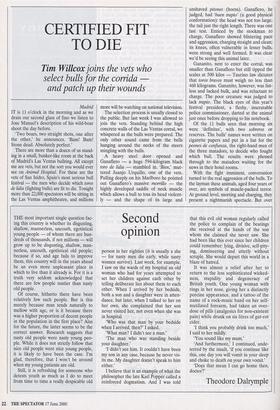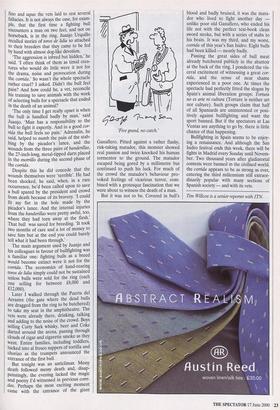CERTIFIED FIT TO DIE
Tim Willcox joins the vets who
select bulls for the corrida — and patch up their wounds
Madrid IT is 11 o'clock in the morning and as we drain our second glass of fino we listen to Jose Manuel's description of his wild-boar shoot the day before.
'Two boars, two straight shots, one after the other,' he announces. 'Barn! Barn! Stone dead. Absolutely perfect.'
There are more than a dozen of us stand- ing in a small, bunker-like room at the back of Madrid's Las Ventas bullring. All except me are vets, but not the sort you would ever see on Animal Hospital. For these are the vets of San Isidro, Spain's most serious bull festival — the men who decide which toros de lidia (fighting bulls) are fit to die. Tonight more than 22,000 spectators will be sitting in the Las Ventas amphitheatre, and millions more will be watching on national television.
The selection process is usually closed to the public. But last week I was allowed to join the vets. Standing behind the high concrete walls of the Las Ventas corral, we whispered as the bulls were prepared. The only other sound came from the bells hanging around the necks of the steers mingling with the bulls.
A heavy steel door opened and Ganaflero — a huge 594-kilogram black tow de lidia — stumbled in. 'Bien,' mut- tered Juanjo Urquillo, one of the vets. Pulling deeply on his Marlboro he pointed out Ganaflero's massive mort-illo — the highly developed saddle of neck muscle which allows a bull to toss its head violent- ly — and the shape of its large and unshaved pitones (horns). Ganaflero, he judged, had `buen trapio' (a good physical conformation): the head was not too large, the tail just the right length. There was one last test. Enticed by the stockman to charge, Ganaflero showed blistering pace and aggression, charging straight and clean; its knees, often vulnerable in lesser bulls, were strong and well formed. It was clear we'd be seeing this animal later.
Gananito, next to enter the corral, was smaller than Ganaflero but still tipped the scales at 500 kilos — Taurino law dictates that toros bravos must weigh no less than 460 kilograms. Gananito, however, was list- less and lacked bulk, and was reluctant to charge. The poor creature was judged to Jack trapio. The black eyes of this year's festival president, a fleshy, inscrutable police commissioner, darted at the animal just once before dropping to his notebook.
Of the 11 bulls seen that morning six were 'clefinites', with two sobreros or reserves. The bulls' names were written on cigarette papers and put in a hat for the peones de confianza, the right-hand men of the three matadors, to decide who fought which bull. The results were phoned through to the matadors waiting for the news in their hotel rooms.
With the fight imminent, conversation turned to the real aggression of the bulls. To the layman these animals, aged four years or over, are symbols of muscle-packed terror. At ground level, snorting and charging, they present a nightmarish spectacle. But over fino and tapas the vets laid to rest several fallacies. It is not always the case, for exam- ple, that the first time a fighting bull encounters a man on two feet, and not on horseback, is in the ring. Juanjo Urquillo recalled stories of toros de lidia so attached to their breeders that they came to be fed by hand with almost dog-like devotion. 'The aggression is inbred but hidden,' he said. often think of them as timid crea- tures who would do little were it not for the drama, noise and provocation during the corrida.' So wasn't the whole spectacle rather cruel? I asked. Didn't the bull feel pain? And how could he, a vet, reconcile his training to save animals with the work of selecting bulls for a spectacle that ended in the death of an animal?
'The only time I get really upset is when the bull is handled badly by man,' said Juanjo. 'Man has a responsibility to the bull to fight it expertly. And in a good cor- nda the bull feels no pain.' Adrenalin, he said, helped to numb the pain of the stab- bing by the picador's lance, and the wounds from the three pairs of banderillas, the 27-inch-long, metal-tipped darts placed in the monillo during the second phase of the corrida.
Despite this he did concede that the wounds themselves were 'terrible'. He had been shocked, he said, when, in a rare occurrence, he'd been called upon to save a bull spared by the president and crowd from death because of its bravely. 'I could fit my fist in the hole made by the Picador's lance. And the internal injuries from the banderillas were pretty awful, too, Where they had torn away at the flesh.' That bull was saved for breeding. 'It took two months of care and a lot of money to save him but at the end you could barely tell what it had been through.' The main argument used by Juanjo and his colleagues in favour of bullfighting was a familiar one: fighting bulls as a breed would become extinct were it not for the corrida. The economics of hand-rearing toros de lidia simply could not be sustained unless bulls were sold for the ring (each one selling for between £8,000 and L12,000). Later I walked through the Puerta del Arrastre (the gate where the dead bulls are dragged from the ring to be butchered) to take my seat in the amphitheatre. The vets were already there, drinking, talking and adding to the noise of the crowd. Boys selling Cutty Sark whisky, beer and Coke darted around the arena, passing through Clouds of cigar and cigarette smoke as they went. Entire families, including toddlers, tucked into al fresco suppers of tortilla and chorizo as the trumpets announced the entrance of the first bull.
But tonight was an anticlimax. Messy death followed messy death and, disap- pointingly, the evening lacked the magic and poetry I'd witnessed in previous corn- das. Perhaps the most exciting moment came with the entrance of the giant 'Five grand, no catch.'
Ganaflero. Pitted against a rather flashy, risk-taking matador, this monster showed real passion and twice knocked his human tormentor to the ground. The matador escaped being gored by a millimetre but continued to push his luck. For much of the crowd the matador's behaviour pro- voked feelings of vicarious terror, com- bined with a grotesque fascination that we were about to witness the death of a man.
But it was not to be. Covered in bull's blood and badly bruised, it was the mata- dor who lived to fight another day — unlike poor old Ganaflero, who ended his life not with the perfect text-book clean sword stroke, but with a series of stabs to his brain. It was my third, and my worst, corrida of this year's San Isidro. Eight bulls had been killed — mostly badly. Passing the great sides of bull meat already butchered publicly in the abattoir at the back of the ring, I pondered the vis- ceral excitement of witnessing a great car- rida, and the sense of near shame experienced in a poor one. At times the spectacle had perfectly fitted the slogan by Spain's animal liberation groups: Tortura no es arte ni cultura (Torture is neither art nor culture). Such groups claim that half of all Spaniards are uninterested or posi- tively against bullfighting and want the sport banned. But if the spectators at Las Ventas are anything to go by, there is little chance of that happening.
Bullfighting in Spain seems to be enjoy- ing a renaissance. And although the San Isidro festival ends this week, there will be fights in Madrid every Sunday until Novem- ber. Two thousand years after gladiatorial contests were banned in the civilised world, the corrida appears to be as strong as ever, entering the third millennium still extraor- dinarily popular with many sections of Spanish society — and with its vets.
Tim Willcox is a senior reporter with ITN.











































































 Previous page
Previous page